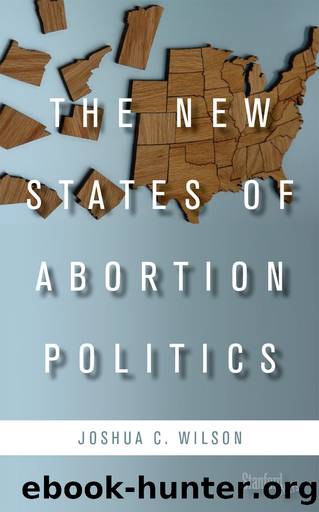The New States of Abortion Politics by Joshua C. Wilson

Author:Joshua C. Wilson [Wilson, Joshua C.]
Language: eng
Format: epub
ISBN: 9780804792028
Barnesnoble:
Publisher: Stanford University Press
Published: 2016-06-08T00:00:00+00:00
PART III
THE PAST AS THE POSSIBLE FUTURE OF ABORTION POLITICS
Considering the possible future of abortion politics first requires taking a long step back before McCullen v. Coakley to understand how abortion policy became a constant in contemporary national politics, how and why the forms of abortion politics have changed over time, and what might reasonably influence their future course. In taking this broad view one sees that while abortion politics are complex and multiple factors influence both their form and prominence on the political stage, the judiciary generally and the United States Supreme Court specifically clearly take a leading role as the areaâs formative engine.
Examining the ascent and decline of various forms of abortion politics reveals the overarching importance of courts, and thus lawyers, in creating what has become the repeated pattern in abortion politics: Antiabortion activists consider their political options given their resources, the greater political climate, and a collection of other factors and then pursue a given strategy. Abortion-rights advocates respond and the antiabortion movementâs tactics or its resulting gains are challenged in court. As local and appellate courts and occasionally the US Supreme Court make rulings on these challenges, they either affirm or redefine the conflictâs parameters and thus the political possibilities that create the disputeâs form, and the cycle starts anew. This in turn underscores the importance of lawyers, as they set the ways the courts can interact with abortion politics by first framing and then appealing cases and by making the arguments that ultimately influence judicial rulings. It is also for these reasons that looking at McCullen and the Courtâs more recent case of Whole Womanâs Health v. Hellerstedt (2016) in light of this deeper history can help us understand what may come next.
The popular story of the beginning of contemporary abortion politics references the Courtâs 1973 ruling in Roe v. Wade as the clear starting point. There is a belief that when the Court ruled, the nation was shocked and the Christian Right immediately took to the streets, the topic instantly becoming a leading national issue. This is not what happened. At the time Roe was decided, conservative white evangelicals who would come to form the core of both the Christian Right and the antiabortion movement were neither organized into an active political force nor that invested in abortion as an issue. Moreover major figures within the Republican Party, which is now recognized as the political home of the Christian Right and the antiabortion movement, were actually pushing for the liberalization of abortion laws.1 In light of this, before abortion politics took their modern form, the Christian Right needed to be created; abortion needed to be presented as a significant issue for this group; and the GOP needed to become tied to both. This process in turn had its beginning roughly one hundred years before Roe.
Abortion first became politicized and then criminalized over the course of the late 19th and early 20th centuries. It was at this time that the medical profession was fighting
Download
This site does not store any files on its server. We only index and link to content provided by other sites. Please contact the content providers to delete copyright contents if any and email us, we'll remove relevant links or contents immediately.
The Rules Do Not Apply by Ariel Levy(4868)
On the Front Line with the Women Who Fight Back by Stacey Dooley(4824)
The Lonely City by Olivia Laing(4751)
Bluets by Maggie Nelson(4478)
The Confidence Code by Katty Kay(4190)
Three Women by Lisa Taddeo(3356)
Not a Diet Book by James Smith(3342)
Inferior by Angela Saini(3278)
Confessions of a Video Vixen by Karrine Steffans(3247)
A Woman Makes a Plan by Maye Musk(3203)
Pledged by Alexandra Robbins(3138)
Wild Words from Wild Women by Stephens Autumn(3095)
Nice Girls Don't Get the Corner Office by Lois P. Frankel(2998)
Brave by Rose McGowan(2787)
Women & Power by Mary Beard(2731)
Why I Am Not a Feminist by Jessa Crispin(2697)
The Clitoral Truth: The Secret World at Your Fingertips by Rebecca Chalker(2672)
The Girl in the Spider's Web: A Lisbeth Salander novel, continuing Stieg Larsson's Millennium Series by Lagercrantz David(2672)
A Burst of Light by Audre Lorde(2548)
